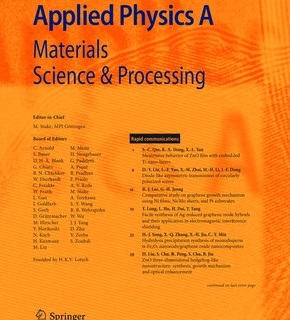Band gap modification and emission of blue-orange luminescence in Gd3+- substituted bismuth nano-ferrites synthesized by modified Pechini chemical route and their applications in LED and solar cells
Abstract
The ferroelectric perovskites, such as BiFeO3 (BFO) has shown great potential as nanophosphors and photovoltaic materials. We have demonstrated a simple and convenient chemical solution deposition method to synthesize Gd doped BiFeO3 nanoparticles. Bi1 − xGdxFeO3 (BGFO) nanoparticles are synthesized by modified Pechini method. Rietveld refinement of X-ray diffraction data confirmed a rhombohedral R3c crystal structure for all compositions. SEM analysis revealed highly crystalline nanoparticles with a decreasing average particle size from 346 nm to 180 nm as Gd concentration increased. Optical studies showed that Gd substitution reduced the band gap from 2.0 eV to 1.87 eV, attributed to lattice distortion and defect-induced sub-bands. There is secondary band gap is also observed around 1.42 eV. Photoluminescence (PL) studies indicated blue emission around 460 nm and orange emissions at 603 nm with PL intensity decreasing upon Gd doping. Commission Internationale de l’Eclairage (CIE) chromatic coordinates and color-correlated temperature were also determined for the prepared nanophosphor. Photovoltaic behavior is obtained in spin coated Bi0.98Gd0.02FeO3 thin films. The incorporation of hole transport layer (P3HT) and electron transport layers (ZnO) significantly improved device performance, increasing Jsc from 0.70 mA/cm² to 3.18 mA/cm², Voc from 0.17 V to 0.504 V and 94% increase in device efficiency. The findings showed that the optimized nanoparticles and thin films could generate a lot of interest for application in blue-orange LED and as semiconducting photoactive layer materials in solar cells.

 求助内容:
求助内容: 应助结果提醒方式:
应助结果提醒方式:


